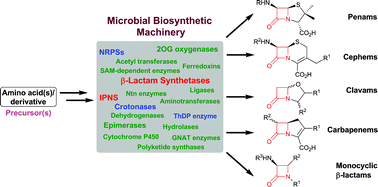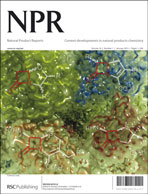The enzymes of β-lactam biosynthesis
Abstract
Covering: up to May 2012
The β-lactam antibiotics and related β-lactamase inhibitors are amongst the most important small molecules in clinical use. Most, but not all, β-lactams including penicillins, cephalosporins, and clavulanic acid are produced via fermentation or via modification of fermented intermediates, with important exceptions being the carbapenems and aztreonam. The desire for more efficient routes to existing antibiotics and for access to new and synthetically challenging ones stimulates continued interest in β-lactam biosynthesis. We review knowledge of the pathways leading to β-lactam antibiotics focusing on the mechanisms, structures and biocatalytic applications of the enzymes involved.

- This article is part of the themed collection: Celebrating our 2019 Prize and Award winners

 Please wait while we load your content...
Please wait while we load your content...